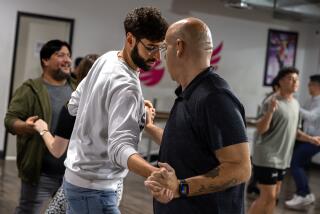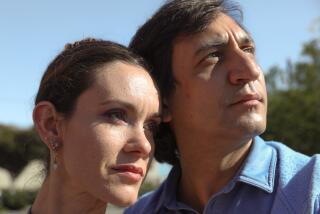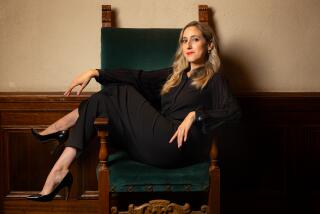Judy Morr: A quiet force behind Segerstrom Center for the Arts’ dance program
The arts world craves star power. Locally, we’re covered. Opera? No problem — Plácido. Classical music? Dudamel. Dance? There’s ... well, anyone there? Anyone at all?
This s explains why perhaps the most important dance figure of the past quarter of a century in Southern California is largely unknown. She’s not a dancer — in point of fact, she hasn’t been en pointe in half a century.
Instead, Judy Morr occupies a comfortably cluttered and modest office, basking happily in as little attention as she can possibly get, quietly programming dance, especially ballet, for as many people she can get to come see it. She is backed by worldwide contacts, an up-to-the-minute knowledge of hot versus not and, most important, the considerable resources of the Segerstrom Center for the Arts, which turns 25 this month.
Morr, 70, the center’s executive vice president, is the sole arts administrator who has worked at the Costa Mesa cultural institution through its entire existence. She is also the person who has made local mavens aim their dance compasses — or GPSes — toward Orange County for a ballet fix. According to center records, 789 dance performances from 1986 through the end of the 2010 season have generated attendance of 1.8 million.
Dance has been available here, in large part, because Morr is a consummate professional and also passionate about dance. “I want to be in that beautiful hall and be dazzled by the physical movement and the musicality of great choreography that takes you over,” she said quietly, during a recent interview.
While the Los Angeles Music Center experienced a dance drought lasting more than a decade and local colleges presented modern companies of erratic quality at an erratic pace, Morr unfailingly brought a world-class dance series to the center that, year in and year out and no matter the economic vagaries, avoided the miasma of “nothing but ‘Nutcracker.’”
Instead, dance diversity in many guises has been on display, as has a robust run of talent from around the world. Review the 50-plus companies that have played the hall and, beyond ballet, one finds stylistic perennials like tango, flamenco and folk. Ballet itself has arrived from six continents, and Russia alone has provided plenty of steps from the steppes in traditional and modern variations.
A constant has been New York-based American Ballet Theatre. Its 21 visits are three times as many as the next most frequently seen company. “The center has been incredibly faithful to us,” said artistic director Kevin McKenzie.
Faithfulness in relationships generally leads to trust, and McKenzie says the level of “trust and honesty” ABT has with Morr and Segerstrom management is unique.
“Most presenters focus on selling tickets,” said McKenzie. “And since most dance-goers come to see pieces they already know, these institutions prefer companies like us to bring them familiar titles. But the center has a sophisticated audience — its dance series mixes the familiar with new works. That’s big for us, because if we only go around dancing ‘Swan Lake,’ as nice as it is, we stagnate.
“And Judy, she gets all that.”
Morr grew up in a rough postwar Irish Catholic neighborhood in South Chicago. Dance lessons came as a respite. And a mid-teen birthday present was tickets to see a first ballet at the downtown Opera House — inevitably, “Swan Lake” — and it was an eye-opener, revealing “an aesthetic that was just at a level so far beyond what I could imagine.”
After college, a preoccupation with theater supplanted dance, and while Morr’s adult aspirations didn’t include acting, the allure of the workings of theater had taken hold. After college she juggled jobs at Boston’s oldest theater, the Colonial, married and had two daughters. But it was a move to Washington in 1971 to work at the newly opened Kennedy Center that focused her direction. D.C. brought Morr into contact with its chairman and guiding force, Roger L. Stevens, one of America’s postwar arts visionaries. Appropriately enough, Morr acquired vision and a mentor.
While not given over to superlatives (asked for the first word that came to mind at the mention of a ballet superstar she worked with over the decades, she thought a moment, and then described Mikhail Baryshnikov as a “hard worker”), the mention of Stevens dropped her soft-spoken voice to a near-whisper: “a genius.”
An example of what she learned: “After Roger had made aesthetic decisions, he absolutely allowed the artists to take that concept and let them develop it and then supported their choices.”
Skip ahead to 2009. Vaunted up-and-coming choreographer Trey McIntyre was commissioned by the center to create a piece that ended up being called “The More I See You.” He was pleased, but cautious — big venues tend to try creative souls.
“As a general rule, organizations in the support of artists get the idea that artists need creative managing,” said McIntyre. “And those outside influences tend to either compromise or blunt your process — you find yourself reacting to input, rather than letting your idea percolate, and then doing it and getting it how you want.”
McIntyre paused and sort of half-laughed. “Judy and I met and she brought up that they want to utilize the plaza in front of the hall as well as the hall. What did I think? I had an idea, and she got excited about it.”
What happened next — or didn’t happen — stayed with McIntyre.
“Her message throughout was, ‘Go do what we brought you to do. It’s your creation.’”
In 1984, with Stevens’ blessing, Morr interviewed with center board members about coming west. Money was being raised, a hall was being built with a 1986 opening in mind, but programming, the lifeblood of an arts institution, was still to be created. Morr’s recollection is typically muted: “I sensed that they were looking for a direction to go. I offered my thoughts and they seemed to like them.”
Morr’s compensation package for 2009-10, the most recent year on record and available through the center’s tax filings, was $218,024, the second highest salary at the institution.
Morr’s vision of booking dance, based on ceaseless work through the years, rests on a deceptively simple foundation: Attract national and world-class dance companies and build the institution’s profile in the process; challenge as well as entertain audiences, and look to prudently market beyond Orange County and Los Angeles; adjust to the ups and downs of the art form and economy, but always search for forward-looking companies and choreographers.
San Francisco Ballet (eighth appearance) starts the new season at the center Sept. 27. In the spring, ABT returns to unveil the latest work from the world’s hottest ballet choreographer, Alexei Ratmansky, who is reworking and modernizing “The Firebird,” the 101-year-old Michel Fokine-Igor Stravinsky staple.
Asked what moved ABT to a world premiere of its new production here (the center did not commission the work), McKenzie mentioned a few reasons, and then, in an afterthought, said something that seemed like it struck him as a given.
“And I knew that Judy would like seeing this one a lot.”
More to Read
The biggest entertainment stories
Get our big stories about Hollywood, film, television, music, arts, culture and more right in your inbox as soon as they publish.
You may occasionally receive promotional content from the Los Angeles Times.






